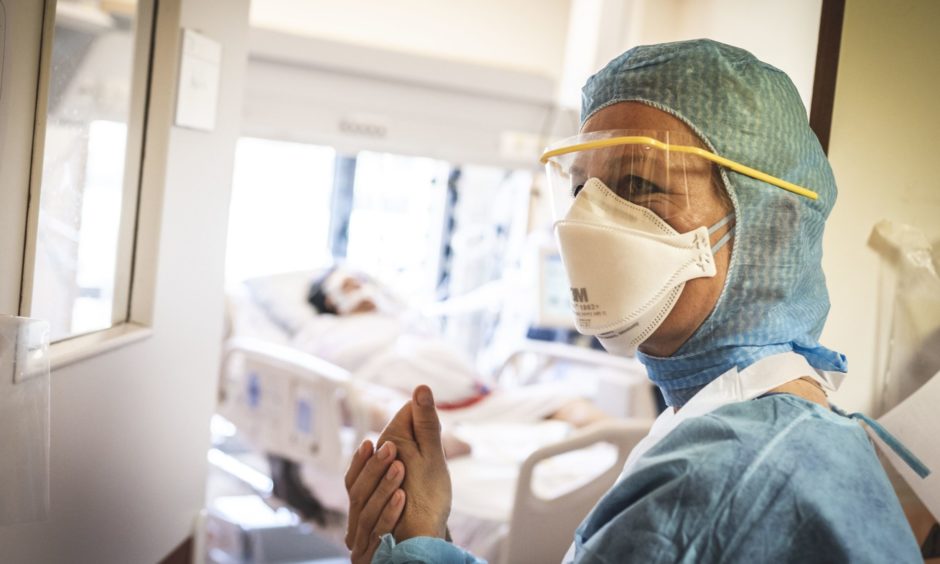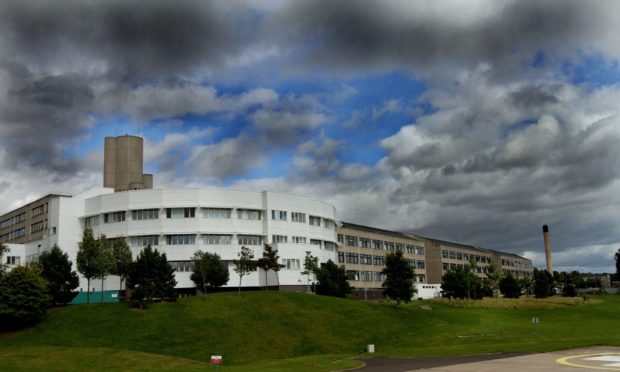The number of people hospitalised with Covid-19 across Tayside has almost doubled since Christmas day, analysis of the latest figures reveals.
Hospitalisation figures across Scotland have risen steadily every day since Christmas with the impact of household mixing on that day only likely to begin to be felt from this week onwards.
The latest figures, released on Wednesday, show coronavirus cases have surged since Christmas day with more than 2,039 new cases of the virus confirmed across the country in the last 24 hours, with a total of 68 deaths recorded in the same timeframe.
Since December 25, the numbers of those hospitalised with the virus has risen steadily every day from 973 patients to 1,384 on Wednesday – up 411 in under a fortnight.

NHS Tayside has seen the number of patients with coronavirus almost double between Christmas day and Wednesday, from 61 to 109.
Crucially, hospital data will only this week begin to reflect the impact of household mixing over Christmas due to a lag of around 10 to 14 days between infection and needing to go to hospital for treatment.
The new, more transmissable variant of Covid-19 has been attributed as causing cases to rise “much more steeply and rapidly” across the country.
We take a deeper look at the latest data available to assess the impact of Christmas and the new variant so far.
People in hospital
Pressure on the NHS has been one of the big concerns of the government as cases are rising.
Nationally, the total number of patients in hospital is close to the peak of April last year but there was also a spike in early November.
The latest figures show there were 1,384 people currently in hospital – 251 more people than was the case exactly a week ago.
There are a total of 95 people in intensive care, an increase of 26 from seven days ago.
Hospitalisations have risen every day since Christmas day when there were 973 patients in hospital to 1,384 on Wednesday.
The numbers in ICU have also experienced a daily increase, with 47 Covid-19 patients in hospital on Christmas day to 95 as of Wednesday.
There is a lag when it comes to hospitalisation figures, meaning the numbers will rise well after the initial infection.
Most people who become seriously unwell with Covid-19 will only enter hospital around 10 to 14 days after their initial infection.
Tayside see numbers in hospital almost double since Christmas
Meanwhile, in Fife, the number of those in hospital rose from 46 on Christmas day to 67 on Wednesday.
Coronavirus cases rising
First Minister Nicola Sturgeon has attributed the new, more transmissable variant of Covid-19 with cases rising “much more steeply and rapidly” than they had been in the latter part of last year.
Speaking during her most recent Covid-19 briefing, on Tuesday, Ms Sturgeon said the new variant of the virus is responsible for around 50% of new cases in Scotland – and that that proportion is rising.
The latest figures show 2,039 people tested positive for the virus, down from 2,529 the previous day.
The country’s test positivity rate is 10.5%.
A regional breakdown shows that 177 of the new cases were recorded in Tayside and 89 in Fife.
Deaths
The latest figures, released on Wednesday, show there were 68 deaths of people who had tested positive for coronavirus in the last 24 hours – the highest total recorded in January so far.
Vaccination statistics
More than 100,000 people have been vaccinated across Scotland.
The first minister said she expects that more than 2.5 million people will have received at least the first dose of the vaccination by May.
That will include everyone on what is called the JCVI priority list – everyone over the age of 50 and people under 50 who have specific underlying health conditions.
Ms Sturgeon has described the situation the country faces as a “race” between the vaccine and the virus due to the spread of the new variant.
She added it may be possible to lift the latest Covid-19 restrictions if the vaccination programme manages to push ahead.
So far, the government has failed to publish vaccination statistics on a daily basis, instead publishing the numbers weekly, but the first minister has said she will consider the frequency of publication.
However, she added she is mindful of not putting too many “burdens” on those working on data collection publication.
Analysis: Publishing daily vaccination stats would provide much-needed hope, says data editor Lesley-Anne Kelly
If you tuned in to the daily Covid-19 briefing on Tuesday – the first briefing since the Christmas break – you may have heard several questions about vaccination data.
Journalists were pressing the first minister on when she would commit to providing daily updates and when she would provide regional breakdowns.
The only vaccination data currently available is a weekly report from Public Health Scotland, which shows the number of people who have received their first dose.
The first minister has often touted her record of providing more data than the other UK administrations, which has very often been the case.
However, in the case of vaccination data, Scotland is sadly lagging behind. Wales has begun providing data broken down by health board on its data dashboard, and England has provided age-disaggregated data.
Boris Johnson also just recently promised “day by day, jab by jab” data would be coming very soon.
Beyond the usual accountability and transparency reasons for providing daily updates of this information, there’s a further, potentially more important reason – hope.
For nine months now we’ve all been hearing daily statistics that have more often than not made for very grim reading.
One of the questions I field regularly is: why can’t we provide more balanced data – for example, why not include data on the number of people who have recovered?
The simple answer is that whilst I would love to, the data doesn’t exist.
There’s no simple definition of what a ‘recovered’ Covid-19 patient is and therefore no metric to share.
Vaccination data does exist, and this is one graph I’m certain everyone would be happy to see exponential growth in.

